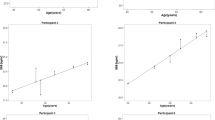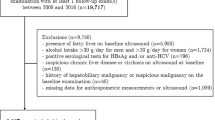Abstract
Objectives:
Although the existence of metabolically healthy obese (MHO) individuals has been recognized, little is known regarding metabolic health status in these subjects over time. Thus, we evaluated longitudinal changes in metabolic parameters among MHO subjects compared with metabolically healthy, normal-weight (MHNW) subjects.
Methods:
A cohort study was performed on 2599 Korean men, 30–59 years of age, with no evidence of fatty liver disease on ultrasound and no traits of metabolic syndrome at baseline. BMI was categorized based on criteria for Asian population. Study participants were followed annually or biennially between 2002 and 2009. At each visit, the fatty liver on ultrasound was assessed and metabolic abnormalities were measured. Parametric Cox models and a pooled logistic regression models were used to evaluate the relationships of BMI with incident metabolic abnormalities.
Results:
During 9647.1 person-years of follow-up, 1673 participants developed metabolic abnormalities. After adjusting for age, smoking, alcohol intake and exercise, higher baseline BMI categories predicted increased incidences of metabolic abnormalities in a dose-response manner. The hazard ratios (95% confidence intervals) for hypertriglyceridemia, prediabetes, pre-hypertension, low high-density lipoprotein-cholesterol, fatty liver, elevated high sensitivity-C reactive protein, elevated homeostasis model assessment of insulin resistance, any metabolic abnormality and metabolic syndrome among the MHO subjects compared with the MHNW subjects were 1.51 (1.23–1.85), 1.43 (1.19–1.72), 1.79 (1.45–2.22), 1.80 (1.30–2.49), 2.69 (2.19–3.31), 1.39 (1.16–1.67), 2.90 (2.31–3.62), 1.68 (1.45–1.93) and 1.84(1.02–3.30), respectively.
Conclusion:
In this study, MHO individuals showed higher incidences of metabolic abnormalities compared with MHNW individuals. This suggests that initially MHO individuals undergo adverse metabolic changes associated with obesity over time.
This is a preview of subscription content, access via your institution
Access options
Subscribe to this journal
Receive 12 print issues and online access
$259.00 per year
only $21.58 per issue
Buy this article
- Purchase on Springer Link
- Instant access to full article PDF
Prices may be subject to local taxes which are calculated during checkout

Similar content being viewed by others
References
Poirier P, Giles TD, Bray GA, Hong Y, Stern JS, Pi-Sunyer FX et al. Obesity and cardiovascular disease: pathophysiology, evaluation, and effect of weight loss: an update of the 1997 American Heart Association Scientific Statement on Obesity and Heart Disease from the Obesity Committee of the Council on Nutrition, Physical Activity, and Metabolism. Circulation 2006; 113: 898–918.
Eckel RH, Kahn R, Robertson RM, Rizza RA . Preventing cardiovascular disease and diabetes: a call to action from the American Diabetes Association and the American Heart Association. Circulation 2006; 113: 2943–2946.
Primeau V, Coderre L, Karelis AD, Brochu M, Lavoie ME, Messier V et al. Characterizing the profile of obese patients who are metabolically healthy. Int J Obes (Lond) 2010; 35: 971–981.
Wildman RP, Muntner P, Reynolds K, McGinn AP, Rajpathak S, Wylie-Rosett J et al. The obese without cardiometabolic risk factor clustering and the normal weight with cardiometabolic risk factor clustering: prevalence and correlates of 2 phenotypes among the US population (NHANES 1999–2004). Arch Intern Med 2008; 168: 1617–1624.
Brochu M, Tchernof A, Dionne IJ, Sites CK, Eltabbakh GH, Sims EA et al. What are the physical characteristics associated with a normal metabolic profile despite a high level of obesity in postmenopausal women? J Clin Endocrinol Metab 2001; 86: 1020–1025.
Sims EA . Are there persons who are obese, but metabolically healthy? Metabolism 2001; 50: 1499–1504.
Meigs JB, Wilson PW, Fox CS, Vasan RS, Nathan DM, Sullivan LM et al. Body mass index, metabolic syndrome, and risk of type 2 diabetes or cardiovascular disease. J Clin Endocrinol Metab 2006; 91: 2906–2912.
St-Pierre AC, Cantin B, Mauriege P, Bergeron J, Dagenais GR, Despres JP et al. Insulin resistance syndrome, body mass index and the risk of ischemic heart disease. CMAJ 2005; 172: 1301–1305.
Arnlov J, Ingelsson E, Sundstrom J, Lind L . Impact of body mass index and the metabolic syndrome on the risk of cardiovascular disease and death in middle-aged men. Circulation 2010; 121: 230–236.
Kuk JL, Ardern CI . Are metabolically normal but obese individuals at lower risk for all-cause mortality? Diabetes Care 2009; 32: 2297–2299.
Marini MA, Succurro E, Frontoni S, Hribal ML, Andreozzi F, Lauro R et al. Metabolically healthy but obese women have an intermediate cardiovascular risk profile between healthy nonobese women and obese insulin-resistant women. Diabetes Care 2007; 30: 2145–2147.
Khan UI, Wang D, Thurston RC, Sowers M, Sutton-Tyrrell K, Matthews KA et al. Burden of subclinical cardiovascular disease in ‘metabolically benign’ and ‘at-risk’ overweight and obese women: The Study of Women's Health Across the Nation (SWAN). Atherosclerosis 2011; 217: 179–186.
Janiszewski PM, Ross R . Effects of weight loss among metabolically healthy obese men and women. Diabetes Care 2010; 33: 1957–1959.
Sesti G, Folli F, Perego L, Hribal ML, Pontiroli AE . Effects of weight loss in metabolically healthy obese subjects after laparoscopic adjustable gastric banding and hypocaloric diet. PLoS One 2011; 6: e17737.
Ryu S, Chang Y, Kim DI, Kim WS, Suh BS . gamma-Glutamyltransferase as a predictor of chronic kidney disease in nonhypertensive and nondiabetic Korean men. Clin Chem 2007; 53: 71–77.
Chang Y, Ryu S, Sung E, Jang Y . Higher concentrations of alanine aminotransferase within the reference interval predict nonalcoholic fatty liver disease. Clin Chem 2007; 53: 686–692.
Chang Y, Ryu S, Sung E, Woo HY, Cho SI, Yoo SH et al. Weight gain within the normal weight range predicts ultrasonographically detected fatty liver in healthy Korean men. Gut 2009; 58: 1419–1425.
Neuschwander-Tetri BA, Caldwell SH . Nonalcoholic steatohepatitis: summary of an AASLD single topic conference. Hepatology 2003; 37: 1202–1219.
Matthews DR, Hosker JP, Rudenski AS, Naylor BA, Treacher DF, Turner RC . Homeostasis model assessment: insulin resistance and beta-cell function from fasting plasma glucose and insulin concentrations in man. Diabetologia 1985; 28: 412–419.
Mathiesen UL, Franzen LE, Aselius H, Resjo M, Jacobsson L, Foberg U et al. Increased liver echogenicity at ultrasound examination reflects degree of steatosis but not of fibrosis in asymptomatic patients with mild/moderate abnormalities of liver transaminases. Dig Liver Dis 2002; 34: 516–522.
Executive summary of the third report of the National Cholesterol Education Program (NCEP) expert panel on detection, evaluation, and treatment of high blood cholesterol in adults (Adult Treatment Panel III). JAMA 2001; 285: 2486–2497.
Alberti KG, Eckel RH, Grundy SM, Zimmet PZ, Cleeman JI, Donato KA et al. Harmonizing the metabolic syndrome: a joint interim statement of the International Diabetes Federation Task Force on Epidemiology and Prevention; National Heart, Lung, and Blood Institute; American Heart Association; World Heart Federation; International Atherosclerosis Society; and International Association for the Study of Obesity. Circulation 2009; 120: 1640–1645.
Marchesini G, Brizi M, Bianchi G, Tomassetti S, Bugianesi E, Lenzi M et al. Nonalcoholic fatty liver disease: a feature of the metabolic syndrome. Diabetes 2001; 50: 1844–1850.
Salamone F, Bugianesi E . Nonalcoholic fatty liver disease: the hepatic trigger of the metabolic syndrome. J Hepatol 2010; 53: 1146–1147.
WHO. Western Pacific Region IaI. The Asia-Pacific Perspective: Redefining Obesity and Its Treatment 2000. Health Communications Australia Pty. Ltd: Sydney, Australia, 2000.
Wen CP, David Cheng TY, Tsai SP, Chan HT, Hsu HL, Hsu CC et al. Are Asians at greater mortality risks for being overweight than Caucasians? Redefining obesity for Asians. Public Health Nutr 2009; 12: 497–506.
Royston P, Parmar MK . Flexible parametric proportional-hazards and proportional-odds models for censored survival data, with application to prognostic modelling and estimation of treatment effects. Stat Med 2002; 21: 2175–2197.
D’Agostino RB, Lee ML, Belanger AJ, Cupples LA, Anderson K, Kannel WB . Relation of pooled logistic regression to time dependent Cox regression analysis: the Framingham Heart Study. Stat Med 1990; 9: 1501–1515.
Arnlov J, Sundstrom J, Ingelsson E, Lind L . Impact of BMI and the metabolic syndrome on the risk of diabetes in middle-aged men. Diabetes Care 2011; 34: 61–65.
Freeman DJ, Norrie J, Caslake MJ, Gaw A, Ford I, Lowe GD et al. C-reactive protein is an independent predictor of risk for the development of diabetes in the West of Scotland Coronary Prevention Study. Diabetes 2002; 51: 1596–1600.
Jacobson TA, Miller M, Schaefer EJ . Hypertriglyceridemia and cardiovascular risk reduction. Clin Ther 2007; 29: 763–777.
Coutinho M, Gerstein HC, Wang Y, Yusuf S . The relationship between glucose and incident cardiovascular events. A metaregression analysis of published data from 20 studies of 95,783 individuals followed for 12.4 years. Diabetes Care 1999; 22: 233–240.
Hamaguchi M, Kojima T, Takeda N, Nagata C, Takeda J, Sarui H et al. Nonalcoholic fatty liver disease is a novel predictor of cardiovascular disease. World J Gastroenterol 2007; 13: 1579–1584.
Tsai SP, Wen CP, Chan HT, Chiang PH, Tsai MK, Cheng TY . The effects of pre-disease risk factors within metabolic syndrome on all-cause and cardiovascular disease mortality. Diabetes Res Clin Pract 2008; 82: 148–156.
Ho JS, Cannaday JJ, Barlow CE, Mitchell TL, Cooper KH, FitzGerald SJ . Relation of the number of metabolic syndrome risk factors with all-cause and cardiovascular mortality. Am J Cardiol 2008; 102: 689–692.
Abdullah A, Wolfe R, Stoelwinder JU, de Courten M, Stevenson C, Walls HL et al. The number of years lived with obesity and the risk of all-cause and cause-specific mortality. Int J Epidemiol 2011; 40: 985–996.
Abdullah A, Stoelwinder J, Shortreed S, Wolfe R, Stevenson C, Walls H et al. The duration of obesity and the risk of type 2 diabetes. Public Health Nutr 2011; 14: 119–126.
Katz A, Nambi SS, Mather K, Baron AD, Follmann DA, Sullivan G et al. Quantitative insulin sensitivity check index: a simple, accurate method for assessing insulin sensitivity in humans. J Clin Endocrinol Metab 2000; 85: 2402–2410.
Acknowledgements
We would like to thank TS Choi (Kangbuk Samsung Hospital, Information System, Seoul, Korea) for his help with technical support in gathering data and also Dr Lina Kim (Edmonton, Alberta, Canada) for her help with revising this paper. This work was supported by the Korea Research Foundation Grant funded by the Korean Government (MOEHRD, Basic Research Promotion Fund) (KRF-2008-331-E00072).
Author information
Authors and Affiliations
Corresponding author
Ethics declarations
Competing interests
The authors declare no conflict of interest.
Additional information
Supplementary Information accompanies the paper on International Journal of Obesity website
Supplementary information
Rights and permissions
About this article
Cite this article
Chang, Y., Ryu, S., Suh, BS. et al. Impact of BMI on the incidence of metabolic abnormalities in metabolically healthy men. Int J Obes 36, 1187–1194 (2012). https://doi.org/10.1038/ijo.2011.247
Received:
Revised:
Accepted:
Published:
Issue Date:
DOI: https://doi.org/10.1038/ijo.2011.247
Keywords
This article is cited by
-
Relevance of body composition in phenotyping the obesities
Reviews in Endocrine and Metabolic Disorders (2023)
-
Individualised prescription of medications for treatment of obesity in adults
Reviews in Endocrine and Metabolic Disorders (2023)
-
Towards an adiposity-related disease framework for the diagnosis and management of obesities
Reviews in Endocrine and Metabolic Disorders (2023)
-
Dietary total antioxidant capacity in relation to metabolic health status in overweight and obese adolescents
Nutrition Journal (2022)
-
Metabolically healthy obesity is associated with longitudinal changes in high-density lipoprotein cholesterol in Chinese adults
Eating and Weight Disorders - Studies on Anorexia, Bulimia and Obesity (2021)



